Casual Adventures -- Testing the Atmosphere
by Becky Waxman
Having
previously discussed
character and
quest focused games in this series of
casual game editorials, I'm now proceeding to another aspect -- atmosphere.
A
game's atmosphere is surprisingly difficult to define, as the concept is
amorphous and somewhat subjective. I've gathered some ideas below to make a
start.
A
Question of Style
Atmosphere begins with a game's visual style. The palette might be dark and
ominous or bright and colorful. Environments can be stylized or
photorealistic; they can give a sense of three dimensional depth, or they
may be flat and cartoon-like.
Once
an art style is established, texture and depth of the environments further
refine atmosphere -- "a sense of the air around you." Think of the
difference between seeing a photograph of a landscape, and viewing a real
landscape, where you can watch the movement of water in a stream and see the
sun glinting in the leaves. Animation and photorealistic graphics can add to
a sense of realism. But stylized gameworlds can be just as affecting when
they use graphics, animations, and camera angles that are consistent with
the imagined world.
In
The Mood
Atmosphere also embraces mood -- and mood is deeply influenced by music and
other sounds. Remember the landscape mentioned earlier, and picture it with
watery sounds from the rushing stream and birdsong from the trees above.
Ambient sound, like visual animation, gives the effect of a larger world,
full of persistent life. Music (especially if it isn't intrusive) can
manipulate emotions on a subconscious level, adding a sense of uneasiness or
melancholy or urgency or delight.
The
most evocative atmosphere is one in which all these elements -- the setting,
visual effects, camera angles, background music, ambient sounds -- work to
establish a consistent sense of place.
Immersion Needn't Mean Drowning
I've
seen the term "immersion" bandied about even more than the term:
"atmospheric." The two are related: the latter can help to induce the
former.
There
are different levels of immersion. One example: you are playing a game that
has drawn you in. You forget that you are at the computer. You forget what
time it is, what day of the week it is, that you haven't eaten in hours. If
it wasn't automatic, you'd forget to breathe. I call this "breathless
immersion."
I
think there's another kind of immersion -- not as intense, but almost as
engaging. You have spent some time in the game, and you're starting to
adjust. By now the visual style is familiar and the gameworld -- whether
realistic or stylized -- is believable. You feel present in the
environments, or you've begun to identify with the hero/heroine that you
control. You start to anticipate story events and look forward to the next
environment to explore. You're officially hooked. I call this "buying in
immersion." You can buy into a world even if you aren't comfortable with
what you find there -- if it scares, unsettles, or challenges you.
Atmosphere is one factor that eases the gamer into an immersive state,
because atmosphere gives a sense of authenticity and adds to the sensation
of being there. And being there is very close to immersion.
Six
Games that Clarify Atmosphere
To
illustrate these ideas, I've included six games described below that fit
loosely into the "casual adventure" category. Simply playing these games
will give you a better sense of the wide range of mood, visual impression
and, yes, atmosphere available in adventure and casual adventure games.
(Since casual adventures are shorter than "core" adventure games, it's
easier to play them side-by-side or one-right-after-the-other in order to
compare them.)
The
discussion below touches on the effect of visuals, viewpoint, voiceovers,
puzzles, characters and sound. The individual game descriptions also
indicate particular features that add or detract from each game's
atmosphere.
I'll
start with a game that fits the most traditional definition of atmospheric
-- a game set in an isolated wood, in an abandoned asylum, where an ancient
evil spreads its horror.
Nightmare Adventures: The
Witch's Prison
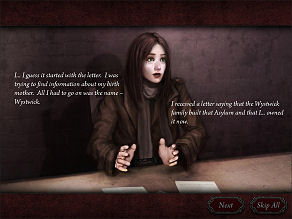
You
assume the role of Kiera Vale, who has just been notified that she has
inherited a family property on which sits the abandoned Blackwater Asylum.
Curious and courageous, Ms. Vale has a sassy modern outlook. Much at the
Blackwater Asylum -- located outside Boston -- has that old-fashioned New
England aura. The place is creepy and decrepit, so our lovely young heroine
is a distinct contrast to her surroundings. The game starts out slowly, with
the full extent of the mystery gradually revealed as you puzzle your way
deeper into the asylum grounds.
The environments in
The Witch's Prison are viewed from straightforward camera angles. The
graphics are naturalistic at first, revealing a gloomy sky, blowing mist,
and a prominent full moon. The visuals gradually become more surreal, with
deep, smudged colors and collage effects. The game draws you into past
iniquities, and you see how modern technology has attempted to deal with
them.
This game is
distinguished by its crucible of puzzles, which bolster the atmosphere of
mystery and decay -- of hidden things that shouldn't see the light of day.
Pattern and code puzzles use occult symbols, and inventory challenges employ
(among other things) bones, poison, and blood. Evidence of the efforts of
others to contain the ancient evil eventually surface, and these create
challenges with a more scientific aspect -- DNA testing, restarting
machinery, and getting past electronic security measures.
This game has a
surprisingly spare touch with one common aspect of atmospheric horror --
sound. Background music is minimal; you mostly hear the ambient sounds:
water flowing, crickets humming, or a wolf howling in the distance. You will
hear occasional voices, but the main character is not voiced. Still, the
story, visual setting, and well integrated puzzles provide the atmosphere
for an unnerving, challenging, engrossing experience.
Do
Puzzles Enhance Atmosphere?
The
puzzles in The Witch's Prison blend well with the environment and
suit the story, so they don't disrupt the atmosphere and they add to
immersion. What about games in which the challenges are distinct from the
environments?
Puzzles that play more like mini-games (rather than integrated challenges)
can bolster atmosphere if they further the story and reveal more about the
characters -- though these are structured to bring engagement in small
gulps, rather than sustained immersion. A good example of this puzzle style
is the Blue Toad Murder Files, which also illustrates how well the
human voice -- arguably the most flexible means for expressing emotion --
can create a compelling atmosphere.
Blue Toad Murder Files
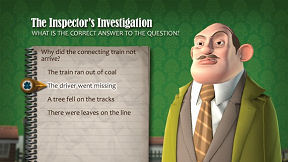
This
game is set in a cartoon-like English village, which you view in 3D flyover
mode, swooping over the grazing sheep and well kept gardens. The atmosphere
is one of pastoral quaintness that overlays a festering secret. You play a
vacationing detective who unexpectedly encounters the eruption of hidden
depravity into...MURDER!
Blue Toad Murder Files
is distinguished by its satiric writing and no-holds-barred humor. Its
atmosphere is hugely bolstered by The Voice, which coaxes, questions,
teases, simpers, and insults. The Voice is Tom Dussek, who does the
voiceover for each character (including the female characters). It's a
remarkable performance -- something like watching Alec Guinness in Kind
Hearts and Coronets, or Patrick Stewart on stage in his one person
production of "A Christmas Carol."
You
never actually walk around the village, but the game takes you overhead and
guides you to each new location, where you interrogate the various villagers
via cut scenes. The puzzles are individual set pieces/mini-games that are
related to each character's needs and concerns. The atmosphere is one of
whimsical tomfoolery, with a certain edginess. You will connect paths,
distinguish differences, solve math problems and figure out anagrams.
Ultimately you must also finger the perpetrator in crimes that range from
leaving dirty footprints on the carpet to...MURDER!
Your
performance is always rated (after failing to find the solution, you can
skip any puzzle if you don't want to try again). When you answer correctly
and within the time limit, The Voice compliments you extravagantly. When you
answer incorrectly or outside the time limit, The Voice scolds you. (You
aren't accused of being The Weakest Link, but the humiliation is roughly
equivalent.)
Of the
six games described in this editorial, this game (despite its comedic tone)
evoked the greatest sense of personal terror. During the cut scenes, I
bought in to the mystery and the humor, but I was subsequently pummeled by
the puzzles. The thrill of victory (achieved by educated guesses to beat the
timer) was outweighed by the inevitable agony of defeat.
Viewpoint and Perspective
Some
gamers find it easier to appreciate the atmosphere and to become immersed in
games in which the viewpoint is from the first person perspective -- where
you are the main character, viewing the gameworld directly. Other gamers
find it easier to immerse themselves in games in which the viewpoint is from
the third person -- where you direct the movements of the character whose
role you are assuming as he or she interacts with the gameworld.
Personally, I find that immersion comes somewhat more quickly in games with
a first person perspective and photorealistic graphics. Below is the game
that, out of the six, provided the style and atmosphere that immersed me
fastest.
The Fall Trilogy Chapter
1: Separation
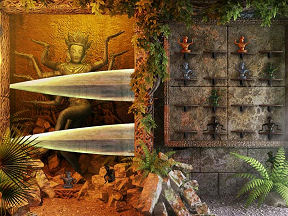
An explorer has fallen
into a pit somewhere in Asia, losing all memory of the past that might
explain why he is there. Colorful, exotic blossoms, intricate foliage, and
carved stone reliefs ornament the walls. Steam rises from a lava pit below,
and light pours in through openings overhead.
Though photorealistic,
this is an idealized setting of impossible beauty. The game creates an
atmosphere of awe accompanied at first by disorientation. Like the Land of
the Lotus Eaters from The Odyssey, it washes away the past and tempts
you to stay. Mood is established through ambient sound -- birds calling,
water rushing, insects chittering. For "buying in" immersion, this game had
me at hello.
Separation
is a first person perspective puzzle adventure with a handful of category
based Hidden Object challenges. The puzzles include inventory challenges and
mini-games, many based on pattern recognition. (One minor atmosphere
disruption: the optional 360 degree panning feature uses the right mouse
button instead of the left mouse button. I never did get used to it.)
You occasionally hear the
protagonist's thoughts, but his personality is undefined. You puzzle through
the locations alone, except for mysterious voices that sometimes sound as
the screen is infused with a brilliant light. The atmosphere is one of
isolation in a slice of paradise, with reality forcing its way in to jar you
into wishing to escape.
Story, Characters, and Expectations
Characters have a tremendous effect on a game's atmosphere, from their
physical appearance to the way they think and speak and react to events.
Games peopled with many minor characters establish a different mood than
games where the protagonist spends most of her time isolated and alone.
Sympathetic, likeable characters tend to create a lighter tone than
difficult, conflicted characters. Assuming the role of a protagonist who is
a mass of contradictions feels more ambiguous and disturbing than assuming
the role of someone whose actions are predictable.
Plot
also affects atmosphere, creating expectations of what will happen as events
unfold. The gamer anticipates upcoming events with an attitude of
trepidation or curiosity or amusement, etc.
Next up is a game in
which the plot, puzzles and characters aim to amuse and charm.
Royal Trouble
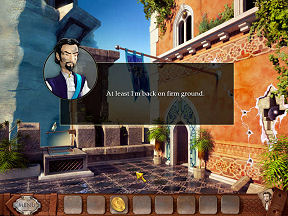
Royal Trouble
takes place in a fairy tale kingdom. The setting is a tropical island under
azure skies, inhabited by a dastardly, shadowy villain. Our two
protagonists, Princess Loreen and Prince Nathaniel, are captives in the
villain's castle. They have never met until they bump into one another while
attempting to escape the dungeons.
Neither Nathaniel nor
Loreen has any compunction about leaving the other behind while scheming to
escape. However, since working at odds with one another results in abject
failure, they conclude that teaming up is their least bad option. Though the
castle and its inhabitants evoke the Renaissance era, the two characters act
and speak with a cheeky, modern attitude.
Loreen is impatient and
high-handed. She is more impressed by the castle's tackiness than by its
owner's cruelty. She thinks Nathaniel can work miracles for her. (She's a
princess, after all.) Nathaniel usually expects the worst, and often finds
it. He calls Loreen "her royal spoiledness," but he's soon resigned to
dashing to her aid whenever she needs him. (He's a prince, after all.)
Dialog between the two and conversations with the eccentric castle occupants
are sarcastic and often pleasingly absurd.
The visual style suits
the fairy tale ambiance. Like the characters, the environments are in
colorful 3D. You'll encounter many inventory item challenges, plus devices
to repair and concoctions to create. The story and gaming challenges call
upon Loreen's wits and Nathaniel's resourcefulness as they improvise their
way through the castle's cellars, kitchens, library, laboratory and towers.
Royal Trouble
is partially voiced through a narrator who, with a suitably droll tone,
relates the background story and comments on the characters as they develop.
The game's only drawback is that the main characters aren't voiced. The mood
is enhanced by background music that reflects the Renaissance era settings;
like the characters and the atmosphere in this game, it is playful, lively
and often comedic.
Embracing the Unfamiliar
and the Suspension of Disbelief
For
readers, the concept of "willing suspension of disbelief" held that the
reader of a story had to work harder to believe in a supernatural world (a
place populated by witches, ghosts or magical beasts, for instance) than in
the real world (a village in England with a freshly murdered corpse, for
instance). An analogy in gaming might be that the gamer has to work harder
to believe in a stylized world -- with hand drawn or cartoon-like graphics
-- than in a naturalistic world with photorealistic graphics.
Atmosphere can immerse, but it can also disturb and challenge. It is a key
factor in forms of entertainment that pull you out of the ordinary and
challenge you with a new way of seeing. Think of the eccentric personal
vision in Tim Burton's films, or the unusual gameworlds in Grim Fandango
or Machinarium -- where the world itself almost becomes another
character in the story.
The two games that follow
are set in hand drawn, surreal worlds with dark themes. Drawn: Dark
Flight is reminiscent of the original tales by the Brothers Grimm. In
it, a lurking evil threatens a kingdom and its innocent young ruler.
Nelson Tethers: Puzzle Agent occupies an absurdist, graphic novel
version of a small town in the U.S., where unknown forces menace the
townspeople.
An intense, quirky
atmosphere is risky. But when it works, as it does in these two games, it's
unforgettable.
Drawn: Dark Flight
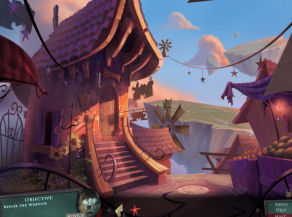
The
opening sequence in Drawn: Dark Flight, takes place in the stone
ruins from the original game: Drawn: The Painted Tower. The main
characters are viewed in fragments. Franklin, the caretaker, has been turned
to stone and then broken -- though he can still communicate. You catch a
glimpse of young Iris in a portrait that is turned on its side and partially
obscured.
The visual style provokes
a sense of unease and apprehension. The environments are viewed from a first
person perspective, and much about them is skewed, full of unsettling
angles. Mist blows through empty streets. The houses are larger at the top
than at the bottom, and monumental buildings and statues spring up in odd
places. Animations are frequent: flickering candlelight, drifting sparks,
flying creatures, falling rain. Mood is set by a pensive vocal melody, aided
by melancholy strings. The game is partially voiced. Franklin's gruff
communications are formal and authoritative. He's desperate, and he's
essentially giving you orders. Iris' voice is delicate and sweet, though
also formal.
The puzzles suit the
game's twisted fairy tale style with a focus on the stuff of childhood --
kites, pop-up books, puppet shows -- tinged with the macabre. Sometimes you
use a paintbrush or crayons and draw or fill in shapes. One fiendishly
difficult challenge involves using little gates to let colors leak together
and blend. It had me leaking multicolored tears.
The sense of brokenness
magically disappears each time you enter one of the paintings or tableaus
that Iris has left scattered about the landscape. Once inside these colorful
scenes, the dramatic tone changes; some scenes even add a comedic touch.
This contrast works well, though I felt that I was "really there" in the
brooding city, but outside "looking in" while viewing the paintings. The
paintings indicate what this world was like before Iris' evil nemesis
destroyed it -- a reminder of what has been lost.
Nelson Tethers: Puzzle
Agent

Atmosphere can help take something dramatic or out of the ordinary and make
it plausible. The story events may be absurd -- outrageous even -- but if
the atmosphere, the environment and the character portrayals are consistent,
you can believe.
Nelson Tethers: Puzzle
Agent has an
off kilter, minimalist tone. It opens in the U.S. Department of Puzzle
Research, in the basement of the J. Edgar Hoover Building, which houses the
FBI. Agent Tethers receives a phone call requesting that he go to Minnesota
and investigate the Scoggins Eraser Factory, whose production of erasers for
the White House has unexpectedly ceased. Eraser production must resume or
(presumably) the President won't be able to correct his mistakes.
The characters in
Puzzle Agent are flat and cartoon-like. They have huge googly eyes.
Heavy black charcoal lines frame their figures. Their skin tone changes,
depending on the background color of the environments. Most of the
characters in the town of Scoggins are suspicious of strangers and obsessed
with puzzles. At first this odd behavior seems related to their isolation in
the frozen tundra of this flat, 2D comic strip world. But something far more
sinister is at hand.
The game is played from
the third person perspective. Investigating the town and the factory
presents Agent Tethers with a series of mini-game-like challenges, sometimes
related to the environments (finding passage for his snowmobile, for
instance), and sometimes as requests for help. None are timed. Whenever you
submit a puzzle solution through official channels, you learn the
ridiculously large amount that the American taxpayer pays to check your
answer.
This game is a brilliant
example of the use of sound to create atmosphere. The background music is
techno modern with eerie flourishes that you would expect from an episode of
"The Twilight Zone." It adds a chill to the air and, at times, an odd sense
of self-parody. Ambient sounds include sinister echoes, crunchy footfalls,
and wailing wind. Voiceovers are spot-on, emphasizing Tethers'
straight-as-an-arrow personality and the townsfolks' nutty obsessiveness.
Without sound, this game
is a tongue-in-cheek cartoon puzzle adventure. With sound, it's a creepy
experience, in a place where something out there is not quite right. The
most improbable of situations becomes oddly believable.
Ten
Atmosphere Disruptors
While
playing the six games I've described above, I encountered atmosphere that
immersed me and, occasionally, aspects that broke that immersion. It's a
complex task to integrate visuals, sound, story, characters, puzzles and
interface, resulting in a memorable atmosphere without discontinuities that
hinder the game's progression.
In
fact, disruptions to atmosphere are common; in the fifteen years I've spent
gaming, I've encountered many. Games seem more prone to these problems than
other media because the gamer doesn't just watch what's going on, but also
interacts with what's going on, which can generate barriers and
inconsistencies. The gamer inevitably encounters technical issues with PC
games -- a problem without parallel in other media -- and this also dispels
the effects of atmosphere.
To
conclude this editorial, I've listed ten factors that (all too frequently)
disrupt atmosphere during the gaming experience.
The
Disruptors:
1.
Glitches, crashes and dead ends.
2. A
difficult or innovative movement control interface. (Keyboard-only
interfaces automatically qualify.)
3.
Repetition. Examples: invisible triggers or other puzzle structures that
require extensive backtracking. Timed puzzles that are so difficult as to
cause multiple failures. Dying and having to restart or retry.
4.
Lack of voiceovers for conversations between characters. (It's more
important to voice conversations than to voice the protagonist's thoughts or
hotspot comments.) Bad voiceovers. Inability to click through voiceovers.
Intrusive or inappropriate music.
5.
Lack of ambient animations where they are clearly called for -- fire or
water that is frozen in time. Cut scenes where the characters look very
different than they do in other parts of the game.
6. An
overly helpful hint system or other messages and alerts that you can't turn
off. Frequent or overly long loading screens. Narration or comments on the
player's actions that are snarky or abusive.
7.
Inconsistency in the story. Examples: the characters don't act in accordance
with their established personalities. The storyline doesn't meet the
expectations it has created.
8.
Inconsistency in the gameplay. Puzzle logic that suddenly changes. Interface
functions that morph mid-game. Puzzles that don't mesh with the
environments or the story.
9.
The game fails to get the details right. Examples: a realistic game that
relies on unrealistic scenarios (e.g., ten different types of weapons lying
on a street corner in midtown Manhattan). A historical era game that gets
historical details wrong (e.g., a Victorian era game in which the heroine
uses modern slang). Hidden Object screens with items that don't suit the
surroundings (modern items in games set in pre-modern eras). Dialogs full of
spelling and grammatical errors.
10.
Overwhelming complexity. Puzzles requiring dozens of sequenced steps
performed perfectly. Games in which the interface requires a learning curve,
plus the intricate story is difficult to follow, plus the challenges are
quirky and layered.
Coming Up Next
Look
to this space to see more discussion of casual games. The next installment
in this series: Casual Companions.
*Note: some of the ideas
for this article were influenced by the following articles: "Realism
VS Idealization" by anjin anhut, and "Analysis:
The Psychology of Immersion in Video Games" by Jamie Madigan.
You can find out more
about the willing suspension of disbelief here at
Wikipedia.
copyright © 2011
GameBoomers